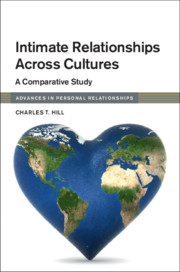Book contents
- Intimate Relationships Across Cultures
- Advances in Personal Relationships
- Intimate Relationships Across Cultures
- Copyright page
- Epigraph
- Contents
- Figures
- Tables
- Spotlights
- Collaborators
- Foreword
- Acknowledgments
- Introduction: Why Was This Book Written?
- 1 How Do We Know What Matters in Intimate Relationships?
- 2 Why Do People Seek Intimate Relationships?
- 3 How Are Intimate Partners Selected?
- 4 What Is Love and How Is Intimacy Expressed?
- 5 How Do Sexual Attitudes and Behaviors Matter?
- 6 What Are the Dynamics of Exchange and Power?
- 7 How Do Couples Cope with Conflict?
- 8 How Do External Factors Matter in Intimate Relationships?
- 9 How Do Intimate Relationships Relate to Well-Being?
- 10 How Do the Predictions Combine in Comprehensive Models?
- 11 How Much Do the Levels of Factors Vary?
- 12 What Are the Implications of the Study?
- 13 How Might the Findings Apply to Other Social Relationships?
- Epilogue: What Future Research Is Needed?
- Glossary of Statistical Terms
- Boston Couples Study Publications
- References
- Index
2 - Why Do People Seek Intimate Relationships?
Published online by Cambridge University Press: 21 June 2019
- Intimate Relationships Across Cultures
- Advances in Personal Relationships
- Intimate Relationships Across Cultures
- Copyright page
- Epigraph
- Contents
- Figures
- Tables
- Spotlights
- Collaborators
- Foreword
- Acknowledgments
- Introduction: Why Was This Book Written?
- 1 How Do We Know What Matters in Intimate Relationships?
- 2 Why Do People Seek Intimate Relationships?
- 3 How Are Intimate Partners Selected?
- 4 What Is Love and How Is Intimacy Expressed?
- 5 How Do Sexual Attitudes and Behaviors Matter?
- 6 What Are the Dynamics of Exchange and Power?
- 7 How Do Couples Cope with Conflict?
- 8 How Do External Factors Matter in Intimate Relationships?
- 9 How Do Intimate Relationships Relate to Well-Being?
- 10 How Do the Predictions Combine in Comprehensive Models?
- 11 How Much Do the Levels of Factors Vary?
- 12 What Are the Implications of the Study?
- 13 How Might the Findings Apply to Other Social Relationships?
- Epilogue: What Future Research Is Needed?
- Glossary of Statistical Terms
- Boston Couples Study Publications
- References
- Index
Summary
Maslow argued that the set of needs listed on the bottom must be met first; then when each set is met, the next higher set emerges. While it is true that the bottom level is necessary for survival, the answers to the cognitive and aesthetic needs teach us how to meet all of the other needs. And meeting social needs provides social support to cope with the stresses involved in meeting needs. Hence, the hierarchical nature of the needs can be questioned.
Social and other needs provide reasons and goals for seeking intimate relationships. Baumeister and Leary (1995) argued that humans have a fundamental need for belonging, and this is included as relatedness along with autonomy and competence as three primary motivations in Self-Determination Theory (Ryan & Deci, 2017). A lack of interpersonal relationships can lead to loneliness (Peplau & Perlman, 1982). Weiss (1974) distinguished between two types of loneliness: emotional (due to lack of intimate relationships) and social (due to lack of a social network). DiTommaso and Spinner (1997) further distinguished between romantic emotional loneliness and family emotional loneliness. Hence, avoiding loneliness is a major reason for seeking an intimate relationship. In the Boston Couples Study, those who broke up reported feeling lonely and depressed (Hill, Rubin, & Peplau, 1976). In addition, loneliness is a major risk factor for mortality, as important as physical factors (Holt-Lunstad et al., 2015).
- Type
- Chapter
- Information
- Intimate Relationships across CulturesA Comparative Study, pp. 36 - 51Publisher: Cambridge University PressPrint publication year: 2019



